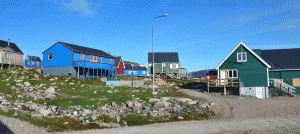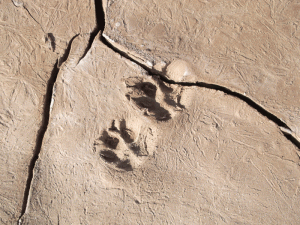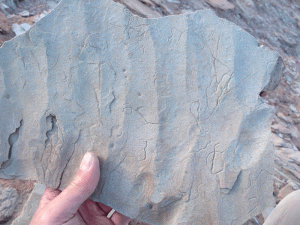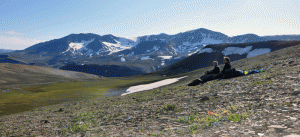Today started well with a plan to head downstream along the Blue River to sample the Permian strata on the coast. We also wanted to see if we could access a large valley called Otocerasdal, which was our last target for the fossiliferous concretion-rich layers. Unfortunately, after a 2-hour hike up and down the deep ravines along Gaffeldal (intending to bypass the Blue River ice tunnel) we got a view up the valley – it was completely filled with ice and a high sandstone cliff blocked the entrance at the lower end. The only access would have to be by traversing the ridge top on the other side and come down from above.
We will have to save that job for another day.
The lower end of the Blue River opened up on the coast. We crossed down into the Permian strata and recovered some brachiopods –stalked filter-feeding invertebrates that have a distinctively asymmetrical valved shell.
Geologically speaking, we had also just walked through the greatest mass extinction event of all time. Over 80% of all life disappeared at the end of the Permian, paving the way for new organisms to radiate including many modern groups.
We also just crossed the Permian-Triassic boundary, representing the dawn of the Mesozoic Era and the beginning of the “Age of Dinosaurs”.
The eastern side of the river had a sparse cover of concretions. These produced some Claraia and the ammonite Wordieoceras.
Everybody then headed down to the river mouth. Ben stayed back after finding a superb specimen of the fish Australosomus. He had taken out some tools to clean away the matrix – a brush and scalpel, the latter used to flake off encrusting dry mud and rock from around the bones.
He then caught us up at the bottom of the river while we stopped for some photos and a bite to eat.
Re-packing the backpacks we started heading out. Unfortunately as Ben swung his bag up onto his back the scalpel slipped out of its container and cut through both the bag and Ben’s leg. His cut was too long and deep for us to deal with. Patching it up with dressings from our medical kit, we left Ben with Henning at the bottom of the river while Grzegorz and Lasse hiked out to call for help on the satellite phone.

Four hours later the helicopter arrived to fly Ben out for medical treatment.
The rest of us sat in camp waiting to find out what would happen next.






